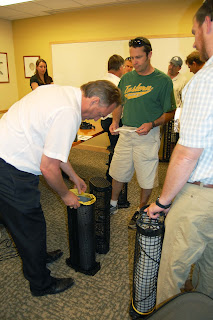June 12, 2012 marked the beginning of a three-day workshop that
brought together fishermen and scientists to review and discuss the known
information on the Atlantic cod stock structure, both past and present. This workshop was Phase I of a three-phase
approach to evaluate the present Atlantic cod stocks and determine if adjustments
need to be made. Hosted by the Gulf of
Maine Research Institute at the Sheraton Hotel in Portsmouth, NH, this workshop
focused on the stock evaluation, including: a general overview of stock
structure boundaries, how current management of the stocks was developed, broad
and fine scale population structure, a comparison of historical vs. present
distributions, implications for stock assessment, and possibility of future
stock changes. Phase II will focus on
how potential changes to the cod stock structure will influence science and
management as well as the advantages and disadvantages of changes to the stock
structure.
Over the course of the three days, a variety of information was
presented to the attending group. In
addition to presentations on the current science being done on cod stock
structures, fishermen expressed their shared concern for the depleting cod
stocks. From the fishermen’s point of
view there is both an economic concern as well as a concern for the
preservation of the fishery. They
expressed a strong willingness to help develop a method for allowing the stocks
to rebuild, but emphasized the importance of including sustainability of their
own businesses into the planning. For
example, fishermen often target areas that support spawning fish because they
support larger fish that fetch a higher sale price. If these areas are closed for portions of the
year to protect cod, fishermen feel that it is important that somehow they are
allowed to offset this loss later in the season.
Many of the attending scientists felt that there was not
sufficient information available to justify strong management response to a
revised understanding of cod stock structure.
However, towards the end of the third day it became clear that no solid
recommendations backed by both scientists and fishermen would be found. So the challenge remains: how do we use incomplete scientific
information to inform management in ways that ensure continued viability of
both fish and fishermen?
For additional information about this topic, please visit: http://www.gmri.org/mini/index.asp?ID=52&p=148





